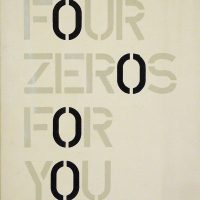Tót’s first artist book entitled My Unpainted Canvasses, published in 1971, can also be regarded as a statement of his break with painting. In the booklet, which imitated a catalogue, the artworks – Tót’s unpainted paintings – were signified by white rectangles of varied proportions and indications of their dimensions. The first artist’s book marked not only the closing of an era, but also the first expressions of his defining idea of nothing, or absence.
“Zer0”, which simultaneously communicated absence and presence, first made its appearance in the artist’s mail art works. This form of artistic communication was, by virtue of the nature of its genre, suitable for conveying Tót’s idea-based art, while also constituting the only means for connecting to the international (western) art scene from behind the iron curtain. Endre Tót initiated correspondence with the most prominent figures of the international avantgarde as early as 1971. The same year his conceptual works were also featured at the Paris Biennial.
For Tót, the “Zer0” sign, which embodied the mathematical concept of nothing, primarily symbolised the absurdity of communication, while, at the same time, the philosophical and political aspects of the character “0” were admittedly important to him as well. During the course of the years, the “0” symbol – which he initially used to replace the text, or certain textual elements, in his letters – gradually took on a life of its own and became the central component of his works employing various media. It appeared in 1972 in the final paintings that followed his break with the genre of painting.
Later, in the late seventies – which also marked the end of Tót’s early conceptual period – it materialized in the form of simple garment buttons in a collage series created in Berlin. The exhibition presents a cross-section type selection of early “Zer0” works, including the most important pieces that were created along the lines of this idea.
